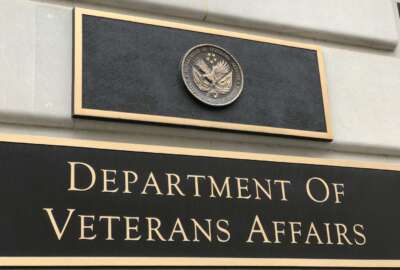
Wilkie says firing of VA deputy secretary was a ‘simple business decision’
Veterans Affairs Secretary Robert Wilkie on Wednesday defended the firing of his deputy secretary, describing the removal as a "simple business decision."
Best listening experience is on Chrome, Firefox or Safari. Subscribe to Federal Drive’s daily audio interviews on Apple Podcasts or PodcastOne.
Veterans Affairs Secretary Robert Wilkie on Wednesday defended the firing of his deputy secretary, describing the removal as a “simple business decision.”
“There are times in any company, in the military and even in Congress, when there are some people in the organization who just don’t gel with the rest of the team,” Wilkie told reporters Wednesday at the National Press Club in Washington, D.C.
Wilkie dismissed Jim Byrne from the deputy secretary position earlier this week. He issued only a short statement on Monday about the firing, which he said was made “due to a loss of confidence” in Byrne’s “ability to carry out his duties.”
“There was nothing personal, but we have so many things going on,” Wilkie said Wednesday. “It has been my mission, my goal, to ensure that everyone who works for us is performing to the utmost. A few years ago we were accused when it came to accountability of holding those at the lowest end of our workforce to account.”
Wilkie denied reports Byrne was fired for his handling of a sexual assault allegation at a VA hospital from a staff member on the House Veterans Affairs Committee. The incident sparked backlash from committee Chairman Mark Takano (D-Calif.).
Wilkie said he met with the department’s inspector general earlier this week about the matter. And he reiterated Byrne’s firing didn’t prompt any disruptions to veterans’ services.
“Even though we have had a change in some of the leadership in our VA, not one appointment has been missed,” Wilkie said. “Not one operation has been canceled. And our veterans are coming to us in numbers that are unprecedented in our history.”
Wilkie offered several assurances that despite the dismissal of his no. 2, the VA was on firm footing. The department has been plagued by several high-profile vacancies throughout the current administration. The undersecretary for health position has been vacant and filled by a rotating cast of acting leaders since the start of the Trump administration.
Byrne had managed the upcoming rollout of the electronic health record , but Wilkie said the project was still on a smooth path. The VA is expected to achieve initial operating capability with the new EHR at its first site next month.
“I don’t think it’ll impact it at all,” Wilkie said when asked about Byrne’s impact on the EHR project.
“I sat down with the Secretary of Defense about a week ago to discuss where we are. This is a joint partnership with the Department of Defense. We are doing well, and MISSION Act [implementation] shows that this VA is capable of pulling off enormously complex programs. I expect us to do well with this venture, as we did with MISSION.”
Senators raise budget concerns with VA MISSION Act
A hearing before the Senate Veterans Affairs Committee earlier Wednesday morning, however, highlighted a few congressional concerns with the implementation of the MISSION Act.
Based on the MISSION Act’s expanded eligibility requirements, the number of patients seeking treatment from VA’s community care providers is expected to jump from 648,000 to 3.7 million veterans.
Richard Stone, the executive in charge for the Veterans Health Administration, said VA has completed 3,000 more appointments within the department during the first quarter of fiscal 2020 compared the same period last year.
Congress stepped in three separate times back in 2017 to provide VA more funding for its community care programs, at the time called “VA Choice.”
Related Stories

VA insists it’s ready for initial EHR deployment at first go-live site in March

Rollout may not be perfect, but VA insists it’s ready for the MISSION Act
“I am concerned that we may be headed down that path again. Eight months into the new community care program VA has not provided or can not provide, one or the other, the number of referrals that became appointments,” Jon Tester (D-Mont.), ranking member of the Senate Veterans Affairs Committee, said. “We get the number of referrals, but we don’t know the number of referrals that become appointments. Thus, I don’t see how we can figure out how many dollars are associated with those appointments and whether usage is in line with the projects that you and other smart people have developed when this program was set up.”
Stone said VA has been spending about $1 billion a month on community care.
“It may reach $1.1 billion. You gave us about $15 billion in the budget. I think we’re safe, but part of this has to do with the timeliness of getting our bills paid, which is an absolute commitment,” he said. “I’m confident at this point that we are sufficiently funded, that we won’t be up here asking for additional dollars.”
VA has struggled, in part, to forecast its community care spend rate due to ongoing delays in paying its community care providers.
It can take up to 180 days to process a veteran’s community care claim and pay the appropriate provider, partly because VA conducts an audit of each and every claim, Kameron Matthews, assistant undersecretary for health for community care, said.
Stone said VA is in the process of setting up a system to auto-adjudicate those community care claims. The department is also changing its business rules to reduce the number of claims they audit.
Copyright © 2025 Federal News Network. All rights reserved. This website is not intended for users located within the European Economic Area.
Nicole Ogrysko is a reporter for Federal News Network focusing on the federal workforce and federal pay and benefits.
Follow @nogryskoWFED



